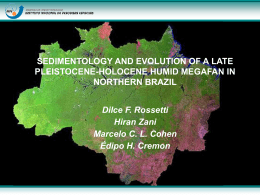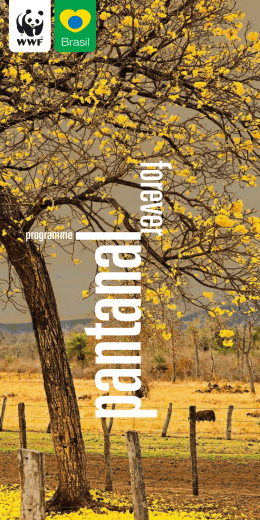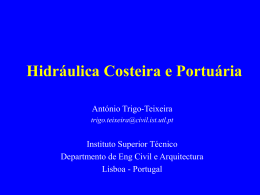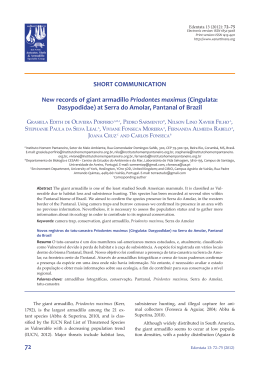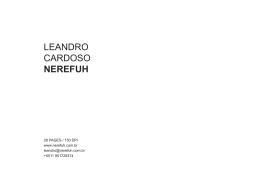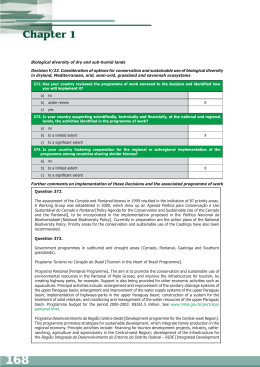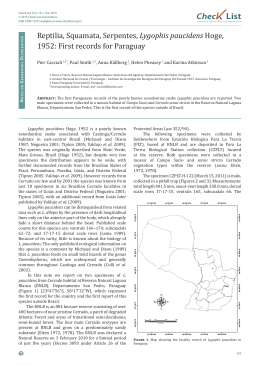Scientific Note Paraguay River Environmental Monitoring by Rede de Proteção e Conservação da Serra do Amolar, Pantanal, Brazil ALESANDRA BERTASSONI1*, NILSON L. XAVIER-FILHO1, FERNANDA A. RABELO1, STEPHANIE P. S. LEAL1, GRASIELA E. O. PORFÍRIO 1,2, VIVIANE F. MOREIRA & ÂNGELO P. C. RABELO1 1 Instituto Homem Pantaneiro, Setor de Meio Ambiente, R. Comendador Domingos Sahib, nº 300, Porto Geral, 79.300130, Corumbá, Mato Grosso do Sul, Brasil. *Corresponding author: [email protected] 2 Universidade de Aveiro, Laboratório de Vida Selvagem do Departamento de Biologia e Centro de Estudos do Ambiente e do Mar (CESAM), 3810-193, Campus de Santiago, Portugal. 3 Universidade Federal de Mato Grosso do Sul, Programa de Pós-graduação em Estudos Fronteiriços, Campus do Pantanal, Av. Rio Branco, nº 1270, 79.370-000, Corumbá, Mato Grosso do Sul, Brasil. Abstract. To value river impacts is essential obtain data about anthropic activities. The Rede de Proteção e Conservação da Serra do Amolar develops monitoring of 310 km on Paraguay River. 1.041 boats were recorded using the river in 2010 and the most frequent activity was fishing. Key words: wetlands, river ecosystem, tourism, fishing, boat, conservation Resumo. Monitoramento Ambiental do Rio Paraguai pela Rede de Proteção e Conservação da Serra do Amolar, Pantanal, Brasil. Para valorar os impactos fluviais é essencial obter dados sobre atividades antrópicas. A Rede de Proteção e Conservação da Serra do Amolar desenvolve monitoramento de 310 km no rio Paraguai. 1.041 barcos foram registrados no rio em 2010 e a atividade mais freqüente foi a pesca. Palavras chave: áreas úmidas, ecossistema fluvial, atividades turísticas, pesca, barcos, conservação The wetlands are among the most fragile and threatened ecosystems, since humid zone’s degradation and loss are faster than those of other ecosystems (Millennium Ecosystem Assessment 2005, Nilsson et al. 2007). The Pantanal wetland, the world’s major floodplain, has an annual flood pulse caused mainly by Paraguay River (Hamilton 1999). From 2.612 kilometers of Paraguay River, 1.693 covers Brazilian territory (Agência Nacional das Águas et al. 2005). In the 1980’s the project of Paraguay-Paraná Waterway was structured to deepen the channel, and facilitate transportation through Pantanal (World Wide Fund for Nature 2001, Zugaib 2006). But in 2000, the Brazilian government declined of the project due to conservation NGOs’ appeal, that were based on the drastic impacts that would be caused on Pantanal’s hydrology (Hamilton 1999, Junk et al. 2006). Nevertheless, private corporations continued to construct infrastructure to the waterway, even against conservationist resistance (Junk et al. 2006, Zugaib 2006). Nowadays, the main activities carried out on this river are navigation, fishing, cargo, livestock watering, irrigation, urban, rural and industrial supply, and recreation. And the impacts caused by these activities are exotic specie’s introduction, natural resource pressure, over-fishing, deforestation of plateau areas, habitat changes and loss, pollution, hydroelectric, dam’s construction, disruption of natural hydrological regime and in riparian vegetation disturbances, improper land use, and infrastructure projects (Silva & Silva 1995, Pan-American Journal of Aquatic Sciences (2012), 7(2): 77-84 78 Hamilton 1999, Girard 2002, Mittermeier et al. 2003, Higgins 2003, Harris et al. 2005, Millennium Ecosystem Assessment 2005, Harris et al. 2006, Junk et al. 2006, Zugaib 2006, Alho 2011). The Pantanal sub-region named Paraguay, due to the river, is sited in western Pantanal (Jesus 2003), and aggregates areas of Poconé, Corumbá and Ladário, and is morphologically bounded by Serra do Amolar and Maciço do Urucum (Junk et al. 2006). The Serra do Amolar is a Precambrian geological control of watershed from Pantanal and plays an important role in the intricate ecological network that integrates rivers, plains and biotic communities (Collischonn et al. 2005). The Brazilian Environment Ministry classifies Serra do Amolar as an area of extremely high importance and priority for biodiversity conservation (Ministério do Meio Ambiente 2007). Recognizing this context the Rede de Proteção e Conservação da Serra do Amolar (RPCSA), a conservation multi-organizational frame to Serra do Amolar, developed the Paraguay River environmental monitoring program. This continuous and long-term project, begun in 2008 and was improved until reach the results of 2010. The program’s main goals are to identify the categories of vessels using the river; to record the boats monthly flow; the activities conducted by them and data concerned about ecological aspects (i.e. presence of mammal species, flowering time, occurrence of migratory birds, aquatic birds nesting). The RPCSA is concerned about the integrity of Serra do Amolar and surroundings of Parna Pantanal, and assumes that the use of landwater resources in Paraguay River can influence the ecosystem. The aims of this study were to identify, to mapping and to diagnose the flow and concentration areas by boats in 2010 on the Paraguay River, in the stretch in which it crosses the region of Pantanal of Paraguay. The RPCSA environmental monitoring area covers a stretch of Paraguay River, from Corumbá – Mato Grosso do Sul State (MS) (19°00’22” S, 57°39’17” O) - up to the Parna Pantanal headquarters (17°50’48” S, 57°24’08” O), and Baía Gaíva (17°43’59” S, 57°40’35” O) encompassing areas from Fazenda Santa Teresa, Private Natural Heritage Reserve (PNHR) Engenheiro Eliezer Batista (EEB), PNHR Penha, Acurizal and Rumo ao Oeste (Fig. 1). The total monitored area reaches 310 kilometers across the river channel and adjacent channels. The climate is classified by Köppen as AW with hot and humid summers and dry winters, where the mean annual precipitation is 1.300 mm (Agência Nacional das Águas et al. 2005). The riparian vegetation is characterized by evergreen A. BERTASSONI ET AL. vegetation to semideciduous alluvial forest (Damasceno-Junior et al. 2004). Also, flooded fields and floating aquatic vegetation are found. The right river bank is characterized by a series of large lagoons, locally known as baías, which are present in Serra do Amolar region (Jesus 2003). The RPCSA 2010’ environmental monitoring was monthly held on four consecutive days by fluvial via, in each day an excerpt of the Paraguay River was studied. The monitoring followed a protocol that defines the procedures for GPS (Global Positioning System) data collection and the record of these into predefined templates. In this case the goal was to standardize the samples. The team loaded in a motorboat 90 hp at an average speed of 40 kilometers per hour recorded the date, time, category, activity and, when possible the name of the boat. The geographic coordinates from each boat were collected by using a GPS unit. The standardization of boat's categories and its performed activities are in Table I. The data were analyzed according to boats occurrence frequencies, and mapped using GIS (Geographic Information System) for qualitative analysis. During 2010, we carried out 12 environmental monitoring monthly and 1.041 boats of all categories were recorded. Of these, 175 were hotel boats, 464 motorboats, 19 vessels, 235 canoes, 123 fishing boats and 25 Marine boats. The motorboats accounted about 44% of all boats. However this kind of boat is generally correlated with the presence of hotel boats, because motorboats are used for tours with fishing tourists inside inland water courses, which do not support hotel boats. A large hotel boat is capable to carry an average of 15 motorboats per trip. January and February were the months with lowest quantities of boats on Paraguay River. After these summer months, there was a gradual increase of boat’s quantities, with a slight decline in April and July. September and October were the months that registered the highest quantities of boats and in November and December the boat’ occurrence started to diminish (Fig. 2). Each boat category was monthly recorded and the boats categories of hotel boat, motorboat and vessel had an occurrence peak in September. The other categories did not show any occurrence pattern. Most activity records by boats contemplates fishing activity (41,4%), followed by sailing (36,6%) and anchored (22%) (Table II). Hotel boat was the category with the highest percentage of anchored, while for sailing the highest percentage was to vessels and to fishing activity the motorboats showed greater percentage (Table III). Pan-American Journal of Aquatic Sciences (2012), 7(2): 77-84 Paraguay River Monitoring, Brazilian Pantanal 79 Figure 1. Study area showing the stretch monitored by Rede de Proteção e Conservação da Serra do Amolar – RPCSA in Paraguay River, Corumbá, Mato Grosso do Sul State. The highlighted areas are part of RPCSA: Fazenda Santa Teresa, Private Natural Heritage Reserve (PNHR) Engenheiro Eliezer Batista, PNHR Penha, Dorochê, Acurizal and Rumo ao Oeste, and Pantanal Matogrossense National Park. Image: UTM 21K WGS 84, Landsat-TM and Rapideye Resourcesat1 (IRS LII-3), Spatial Resolution: 30 and 24 meters (produced by Stephanie Leal). The maps showed that some specific excerpts of Paraguay River had, in almost all months, a great boat concentration. These concentrations were defined as a boat cluster in a geographic location. Two kinds of concentrations were found, one is canoes nearby traditional communities and the other is hotel boat and motorboats. One of the canoe concentrations is about 40 km from Corumbá (Concentration V) and the other is in Barra do São Lourenço community (Concentration IV), near the encounter between the Paraguay and Cuiabá Rivers. The hotel boats and motorboats concentrations were present at sites in Paraguay River that have curves and meanders along adjacent inland water courses (channels and baías) and we defined four such concentrations (I, II, III, VI) along the Paraguay River (Fig. 3). We registered in those sites 126 concentrations of hotel boats and motorboats during the year, and 95 (75.4%) were anchored. Pan-American Journal of Aquatic Sciences (2012), 7(2): 77-84 80 A. BERTASSONI ET AL. Table I. Boat types, characteristics and its function, and the activity that it performed in Paraguay River, in a stretch monitored by Rede de Proteção e Conservação da Serra do Amolar – RPCSA in Paraguay River, Corumbá, Mato Grosso do Sul State. Categories and profile of boats recorded in Paraguay River Boat type Characteristics Hotel boat Range: 30 to 50 m. Transports passengers and overnight. Could attach a wide number of motorboats, depending on its capacity. Motorboat Range: up to 3 m. Metal utility motorboat. Engine power ranging from 15 to 150 hp. Vessel Range: up to 50 m. Flat-bottomed vessel. Could be in a train configuration and/or being pushed or pulled by a tug-boat. Canoe Range: up to 6 m. Wooden boat without motor which moves through paddles. Fishing boat Range: from 4.5 to 15 m. Wooden or metal boat, with an internal motor which carries eight crewmembers. Marine Range: from motorboats to large yachts. Boats of Brazilian Navy. Activities performed by boats recorded in Paraguay River Activities Definition Fishing People are catching fish by net, hook or any other procedure. Anchored A static boat. Sailing A boat in motion. Environmental monitoring based on physical, chemical and bacteriological characteristics are very important to access water quality, yet are not sufficient to attempt the other elements related to water resources and its multiple uses, being deficient in the evaluation of aesthetics, recreational and ecological quality (Santos et al. 1995, Thomson et al. 2001). The improvement of this assessment is a kind of monitoring that searches for to characterize and to categorize the influence of human actions on ecosystems (Rodrigues et al. Function Tourism, especially fishing. To promote fishing and tourism tours. Transport cargo. Subsistence fishing and bait capture. Fishing of large stocks to trade. Military functions. 2010). The RPCSA environmental monitoring had categorized boats types and its activities on Paraguay River, once the nature of river impacts are dependent of these information. For example, the impact of hotel boat in the river bank because of the ripples (World Wide Fund for Nature 2001) is different than the impact caused on the same river bank by a canoe. However, a canoe which is fishing routinely in a closed water system, such as a baía, can locally deplete the fish population. Figure 2. Boat occurrence registered monthly in 2010 by Rede de Proteção e Conservação da Serra do Amolar – RPCSA in Paraguay River, Corumbá, Mato Grosso do Sul State. Pan-American Journal of Aquatic Sciences (2012), 7(2): 77-84 Paraguay River Monitoring, Brazilian Pantanal 81 Table II. Activities performed by all boat types recorded in Paraguay River in 2010 by Rede de Proteção e Conservação da Serra do Amolar – RPCSA in Paraguay River, Corumbá, Mato Grosso do Sul State. Activities Number of boats % Anchored Sailing Fishing Total 225 383 433 1.041 22 36.6 41.4 100 The total number of all boats on all categories in 2010 was 1.041. The lack of data regarding the flow of boats and cargo capacity on Paraguay River does not assign value to that number. However, this is the first research to quantify the boats flow and its use in this important river, even in a portion of it. Overall, it is important to obtain information that helps to understand how the fluvial system works and its fragilities. Higgins (2003) states that planning for conservation is important to gather information on the use of natural resources of the site. Human interference in freshwater ecosystems has been roundly affecting their natural physical and biological characteristics, altering the productivity and resilience (Nilsson et al. 2007). Thus the assessment of habitat’s physical structure, boats flow and their uses on the river influences its dynamics. Table III. Boat types that use the Paraguay River and the percentages of the activities recorded monthly in 2010 by Rede de Proteção e Conservação da Serra do Amolar – RPCSA in Paraguay River, Corumbá, Mato Grosso do Sul State. Boat type Hotel boat (175) Motorboat (464) Vessel (19) Canoe (235) Fishing Boat (123) Marine (25) Anchored (%) 67.4 6.3 15.8 6.4 36.6 60 Sailing (%) 31.4 27.2 84.2 42.5 61 40 In MS State it is considered a crime to fish in the spawning fish (“piracema”) and every year Imasul, State environmental agency, issued a law with the interdiction time, called “época de defeso”, where people are not allowed to fish. This corroborates with the low occurrence of boats in January, February, November and December 2010. Catella et al. (2008) in a study focusing in Pantanal fisheries statistics also did not report fishing occurrence during the época de defeso, registering only the fish trade. The decline on boats flow in April could be related to the “dequada” time. This is a natural phenomenon, in Pantanal, in which occurs the deterioration of water quality leading to decomposition of organic matter due to the annual flood and drought cycle. Fishing during this period becomes impractical due to moribund condition of the fish. The decrease in the boats flow during the época de defeso and “dequada” time demonstrates that the majority of boats are using the monitored portion of Paraguay River to fish. The occurrence peak of hotel boats, motorboats and vessels in September confirm the studies of Albuquerque & Catella 2009 and Fishing (%) 1.2 66.5 0 51.1 2.4 0 Albuquerque & Catella 2010, which observed a high fishing season since July, with peaks on September and October. A series of factors compete for the majority of fishing tourists schedule their trips from July to October, some of them related to seasonal variations, such as the expected increase in the income of fisheries in the driest months and decrease in rainfall. The canoe concentrations near to traditional communities from Corumbá and Barra do São Lourenço reflects on the dependency of these people in fish and taking bait for their survival and income generation. The hotel boat and motorboats concentration are near to Paraguay River sites with inland water courses, which are recognized by fishermen as great places to fish because are fishes reproduction sites. Since a high percentage of hotel boats were anchored (75.4%) in these concentrations, it appears that possibly these sites and their river banks are being used as a wharf for hotel boats to serve as support to the motorboats, which are probably using the adjacent water bodies to fishing. This inference corroborates with World Wide Fund for Nature (2001) which assumes that to Pan-American Journal of Aquatic Sciences (2012), 7(2): 77-84 82 reach the preferred fishing points, tourist’s transportation is performed by motorboats. Still, the choice of these hotel boats anchor points may be related to bait supply and local crafts made by A. BERTASSONI ET AL. traditional people to tourists and/or places on the riverside that have physical conditions for anchoring (i.e. depth, presence of river bank and large trees to anchor the boat). Figure 3. Boat concentrations found by Rede de Proteção e Conservação da Serra do Amolar – RPCSA in Paraguay River, Corumbá, Mato Grosso do Sul State. Concentration I, II, III and VI: concentration of hotel boat and motorboats. Concentration IV and V: canoes nearby traditional communities of Barra do São Lourenço and Corumbá, respectively. Image: UTM 21K WGS 84, Landsat-TM and Rapideye Resourcesat1 (IRS LII-3), Spatial Resolution: 30 and 24 meters (produced by Stephanie Leal). The increase in fishing tourism stimulates the local economy, however, also brings environmental problems (e.g. irregular sailing, boats increase on the river channel, over-fishing, illegal camping on the riversides, spread of waste, poaching and illegal fishing), mainly by sport fishermen (In 2007 were 17.249 sport fishermen in Paraguay River Basin in MS State) (World Wide Fund for Nature 2001, Junk et al. 2006, Albuquerque & Catella 2010, Alho 2011). The great boat flow still causes discomforts for local people - they condemn the use of motorboats on Pantanal Rivers since this type of boat disrupts the traditional fishing to be very noisy, produce ripples and thus scare away the fish (Silva & Silva 1995). Any proposal for an integrated ecosystem management, through long term studies, needs to be based not only in addressing ecological and landscape levels, but also in socio-economic and cultural factors (Pahl-Wostl 2006). Networks actions on protected areas involving environmental monitoring in any focus play an important role given the fact that individual areas are often functionally linked by hydrology (Millenium Ecosystem Pan-American Journal of Aquatic Sciences (2012), 7(2): 77-84 Paraguay River Monitoring, Brazilian Pantanal 83 Assessment 2005). This is the case of RPCSA monitoring and also emphasizes that monitoring of water resources is one of the recommendations of the Conservation Strategic Action Program of the Integrated Management of the Pantanal and the Upper Paraguay River Basin (Agência Nacional das Águas et al. 2005). The environmental monitoring conducted by RPCSA is justified since fluvial navigation could be considered as an external action that causes changes in the physical, biotic and socioeconomics (World Wide Fund for Nature 2001). A short term study made by World Wide Fund for Nature – WWF detected some impacts on natural environment related to boats, such as: physical deterioration on riverside, the levees, clearing of riparian vegetation and changes in archaeological sites (World Wide Fund for Nature 2001). The RPCSA environmental monitoring on Paraguay River, a long term and continuous project, improves itself with the needs and demands in favor of conservation, and in 2011 was initiated, in conjunction with the existing actions, the physical and chemical water parameters monitoring at strategic points of Paraguay River. As well, the increase in monitoring stretch about 200 kilometers from Porto Jofre to Parna Pantanal by Cuiabá River. With these improvements RPCSA tries to add value to environmental monitoring, as well as search for environmental biomarkers of quality in Paraguay River. Still, the data of boats flow, especially the concentrations, may indicate zoning areas for fishing. Thus RPCSA environmental monitoring is a tool towards the evaluation and conservation of the river system of the Paraguay River. Acknowledgments To the founders and partners of RPCSA: Instituto Homem Pantaneiro, Ecotrópica – Fundação de Apoio à vida nos trópicos, Fazenda Santa Teresa, Parque Nacional do Pantanal Matogrossese and Instituto Chico Mendes de Conservação da Biodiversidade (ICMBio). References Albuquerque, F. F. & Catella, A. C. 2009. Sistema de Controle de Pesca de Mato Grosso do Sul: SCPESCA/MS 12-2005. Embrapa Pantanal e IMASUL, Corumbá, Brasil, 57 p. Albuquerque, S. P. & Catella, A. C. 2010. Sistema de Controle da Pesca de Mato Grosso do Sul - SCPESCA/MS 14 – 2007. Embrapa Pantanal e IMASUL, Corumbá, Brasil, 49 p. Alho, C. J. R. 2011. Biodiversity of the Pantanal: its magnitude, human occupation, environmental threats and challenges for conservation. Brazilian Journal of Biology, 71(1, suppl.): 229-232. Agência Nacional das Águas – ANA, Global Environmental Facility – GEF, Programa das Nações Unidas para o Meio Ambiente PNUMA & Organization of American States OAS. 2005. Strategic Action Program of the Integrated Management of the Pantanal and the Upper Paraguay River Basin – Final Report. TDA Desenho e Arte, Brasília, Brasil, 320 p. Catella, A. C., Mascarenhas, R. O., Albuquerque, S. P., Albuquerque, F. F. & Theodoro, E. R. M. 2008. Sistemas de estatísticas pesqueiras no Pantanal, Brasil: aspectos técnicos e políticos. Pan-American Journal of Aquatic Sciences, 3(3): 174-192. Collischonn, B., Bravo, J. M., Collischonn, W., Allasia, D., Villanueva, A. & Tucci, C. E. M. 2005. Estimativa preliminar do comprimento do remanso do rio Paraguai a montante de Amolar. Águasul - Simpósio de Recursos Hídricos do Sul, Santa Maria, Rio Grande do Sul, Brasil, 1-9. Damasceno-Junior, G. A., Semir, J., Dos Santos, F. A. M. & Leitão-Filho, H. F. 2004. Tree mortality in a riparian forest at Rio Paraguai, Pantanal, Brazil, after an extreme flooding. Acta Botanica Brasilica, 18(4): 839-846. Girard, P. 2002. Efeito cumulativo das barragens no Pantanal. Instituto Centro Vida, Campo Grande, Brasil, 28 p. Hamilton, S. K. 1999. Potential effects of a major navigation project (Paraguay–Paraná Hidrovía) on inundation in the Pantanal floodplains. Regulated Rivers: Research & Management, 15: 289–299. Harris, M. B., Tomas, W., Mourão, G., Da Silva, C. J., Guimarães, E., Sonoda, F. & Fachim, E. 2005. Safeguarding the Pantanal Wetland: Threats and conservation initiatives. Conservation Biology, 19(3): 714-720. Harris, M. B., Arcângelo, C., Pinto, E. C. T., Camargo, G., Neto, M. B. R. & Silva, S. M. 2006. Estimated loss of natural cover in Upper Paraguay River Basin and the Brazilian Pantanal. Natureza & Conservação, 4(2): 138-163. Higgins, J. V. 2003. Maintaining the ebbs and flows of the landscape: Conservation Planning for freshwater ecosystems. Pp. 291-318. In: Groves, C. R. (Ed.). Drafting a conservation blueprint: a practitioner’s guide to regional planning for biodiversity. Island Press, Pan-American Journal of Aquatic Sciences (2012), 7(2): 77-84 84 Washington, D. C., United States of America, 457 p. Higgins, J. V., Bryer, M. T., Khoury, M. L. & Fitzhugh, T. W. 2005. A freshwater classification approach for biodiversity conservation planning. Conservation Biology, 19(2): 432-445. Jesus, F. 2003. Classificação dos ecossistemas aquáticos do Pantanal e da Bacia do Paraguai. The Nature Conservancy, Brasília, Brasil, 108 p. Junk, W. J., Cunha, C. N., Wantzen, K. M., Petermann, P., Strüssmann, C, Marques, M. I. & Adis, J. 2006. Biodiversity and its conservation in the Pantanal of Mato Grosso, Brazil. Aquatic Sciences, 68: 1-32. Millennium Ecosystem Assessment. 2005. Ecosystems and Human Well-Being: Wetlands and Water - Synthesis. World Resources Institute, Washington, United States of America, 68 p. Mittermeier, R. A., Mittermeier, C. G., Brooks, T. M., Pilgrim, J. D., Konstant, W. R., Da Fonseca, G. A. B. & Kormos, C. 2003. Wilderness and biodiversity conservation. Proceedings of the National Academy of Sciences, 100(18): 10309-10313. Ministério do Meio Ambiente - MMA. 2007. Áreas prioritárias para a Conservação, Uso Sustentável, e Repartição de Benefícios da Biodiversidade Brasileira. MMA, Brasília, Brasil, 301 p. Nilsson, C., Jansson, R., Malmgvist, B. & Naiman, R. 2007. Restoring riverine landscapes: the challenge of identifying priorities, reference states, and techniques. Ecology and Society, 12(1): 1-7. Pahl-Wostl, C. 2006. The importance of social A. BERTASSONI ET AL. learning in restoring the multifunctionality of rivers and floodplains. Ecology and Society, 11(1): 1-14. Rodrigues, A. S. L., Malafaia, G. & Castro, P. T. A. 2010. Importance of habitat assessment in monitoring quality of water resources: a review. Revista de Saúde e Biologia, 5(1): 26-42. Santos, J. E., Feresin, E. G., Ballester, M. V. R., Jesus, T. P., Pires, J. S. R., Barroso, G. F., Krusche, A. V., Albuquerque, A. L. S., Obara, A. T., Pozzi, E. G., Mozeto, A. A., Cavalheiro, F., Margarido, L. A. & Gentil, J. G. 1995. Utilização da abordagem sistêmica para o manejo de áreas naturais. Caso de estudo: Estação Ecológica de Jataí, Luiz Antonio, SP. Oecologia Brasiliensis, 1: 487502. Silva, C. J. & Silva, J. A. F. 1995. No ritmo das águas do pantanal. NUPAUB/USP, São Paulo, Brasil, 210 p. Thomson, J. R., Taylor, M. P., Fryirs, K. A. & Brierley, G. J. 2001. A geomorphological framework for river characterization and habitat assessment. Aquatic Conservation: Marine and Freshwater Ecosystems, 11: 373–389. World Wide Fund for Nature – WWF. 2001. Retrato da navegação no Alto Rio Paraguai: Relatório da Expedição técnica realizada entre os dias 03 e 14 de novembro de 1999, no Rio Paraguai, entre Cáceres (MT) e Porto Murtinho (MS). WWF, Brasília, Brasil, 63 p. Zugaib, E. 2006. A Hidrovia Paraguai-Paraná e seu significado para a diplomacia sulamericana do Brasil. Funag, Brasília, Brasil, 438 p. Received December 2011 Accepted April 2012 Published online June 2012 Pan-American Journal of Aquatic Sciences (2012), 7(2): 77-84
Download
